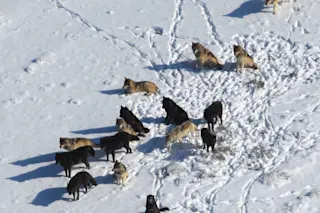If you take a peek at a pack of gray wolves, you might see a sea of gray fur. That said, you might also see a stunning array of silvers and soots and smoky blacks, as well as an assortment of additional shades from brown to beige to white.
Much more striking than the colors themselves is their cause. In fact, according to a paper published in Science this fall, some scientists think that the patterns of coat coloration among North American wolves are actually a sign of past sicknesses.
More specifically, these scientists say that the colors of wolves signal the strength of their immunity to specific viruses, allowing individual wolves to identify which partners will provide them with resilient, virus-resistant pups.
Wolves come in an assortment of colors, though they’re generally gray and black in North America, with a greater prevalence of gray tones to the north and ...















